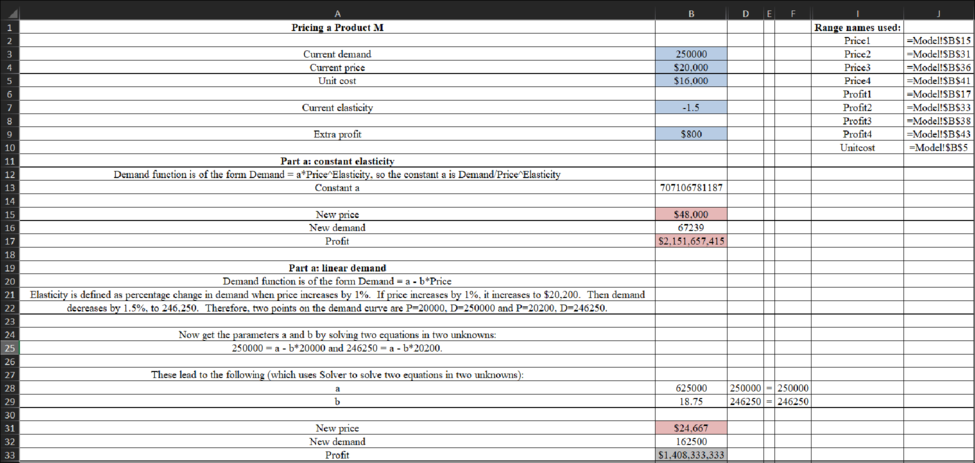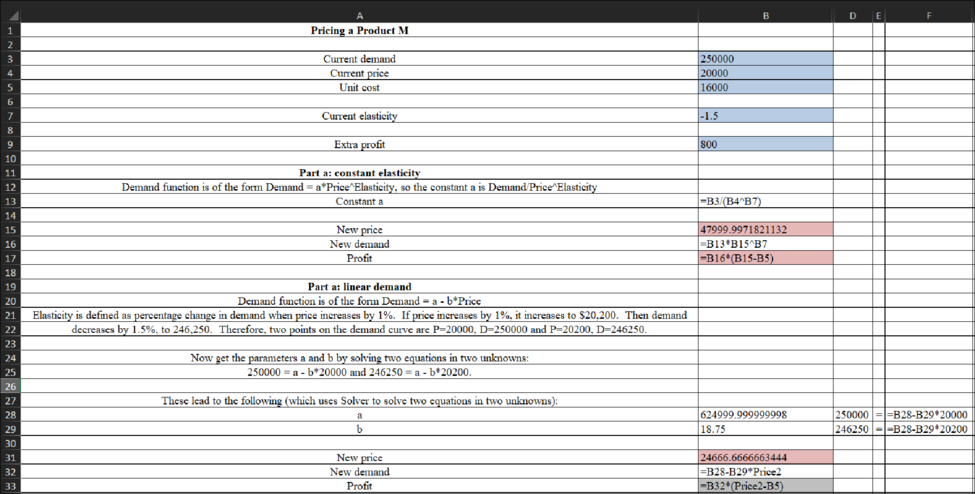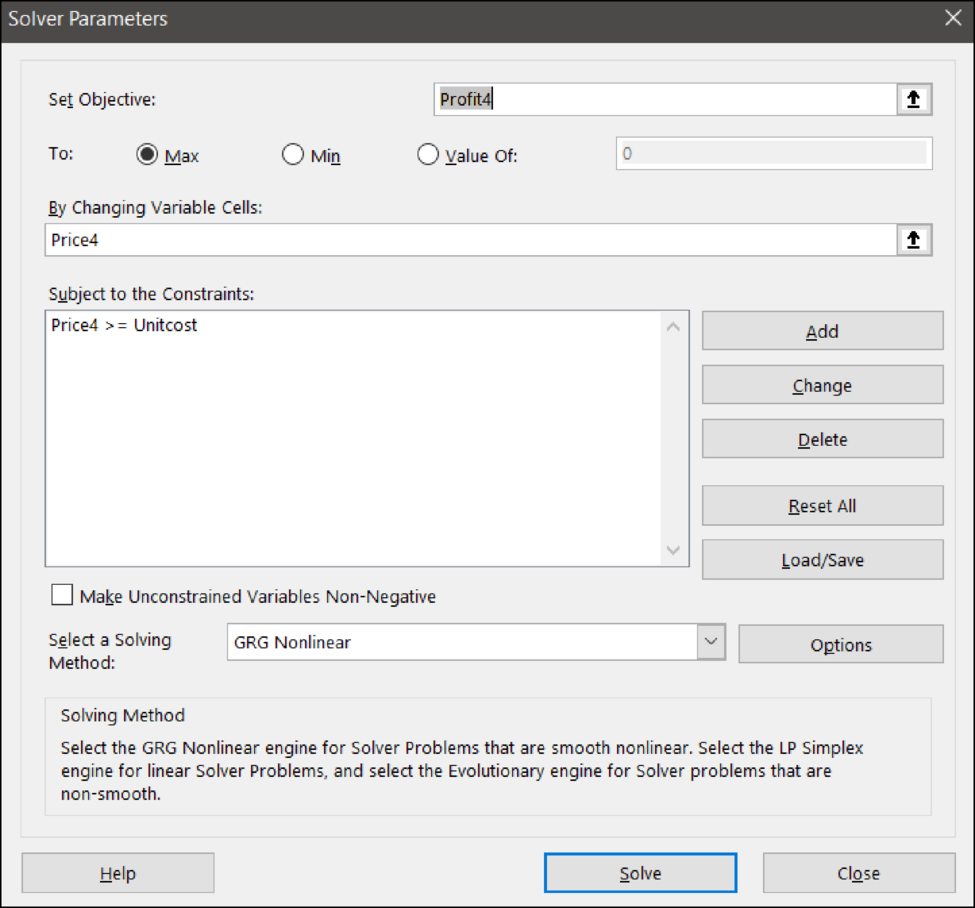
Practical Management Science
6th Edition
ISBN: 9781337406659
Author: WINSTON, Wayne L.
Publisher: Cengage,
expand_more
expand_more
format_list_bulleted
Concept explainers
Question
Chapter 7, Problem 45P
a)
Summary Introduction
To determine: The profit-maximizing price of Product M when the demand function is constant elasticity and also linear.
Non-linear programming (NLP):
Non-linear programming (NLP) is used in complex optimization problems where the objectives or constraints or sometimes both are non-linear functions of the decision variables. A model can be termed as non-linear for more than one reason.
a)
Expert Solution
Explanation of Solution
Model

Formula:

Solver input:

b)
Summary Introduction
To determine: The profit-maximizing price of Product M when the demand function is constant elasticity and also linear for an additional profit of $800.
b)
Expert Solution
Explanation of Solution
Model


Formula:


Solver input:

Want to see more full solutions like this?
Subscribe now to access step-by-step solutions to millions of textbook problems written by subject matter experts!
Students have asked these similar questions
A firm's short-run production function is given with Q(K, L) = L0.2* K2 . Capital is fixed with K=3. The price of capital is r = 0.1 and the price of labour is w = 4 The price of the final output is p = 8
a) Do you think it is possible to depict this production function with an isoquant? Justify your answer by explaining the concept of an isoquant.
b) Calculate the optimum quantity of labour the firm should use if it wants to maximize its profit. Also calculate the output produced and the corresponding profit.
2.
A firm makes two products, Y and Z. Each unit of Y costs $10 and sells for $40. Each unit of Z costs $5 and sells for $25. If the firm's goal is to maximize profit, what would be the appropriate objective function?
Select one:
a.
Maximize profit Z = $10Y + $25Z
b.
Maximize profit Z = 0.25Y + 0.20Z
c.
Maximize profit Z = $40Y + $25Z
d.
Maximize profit Z = $50(Y + Z)
e.
Maximize profit Z = $30Y + $20Z
(1) When chef Paolo prices his speciality ‘pizza-n-all’ meal at £25, he sells 20 meals a day.
When he prices his pizza meal at £22, he sells 21 meals a day.
Suppose Paolo reduces his price from £25 to £22. Explain the impact of the price reduction on the revenue he receives from the first 20 meals he sells.
Total Revenue – Price X Quantity.
Revenue @ £25 = £25 X 20 = £500.
Revenue @ £22 = £25 X 20 = £440
The impact of the price reduction is a reduction in total revenue of £60 (-12%) over the first 20 meals that he sells.
Calculate the additional revenue generated from the additional meals he sells when he lowers his price to £22.
Total Revenue = Price X Quantity.
Total Revenue @ £22 = £22 X 21 = £462.
Additional Revenue = Revenue @ £25 – revenue @ £22 = £500 - £462 = -£38.
Calculate the marginal revenue Paolo receives from the 21st meal. How does that amount relate to the amounts you calculated in (a) and (b)? (3%)
Suppose Paolo reduces his price from £25 to £22. Explain…
Chapter 7 Solutions
Practical Management Science
Ch. 7.3 - Prob. 1PCh. 7.3 - Prob. 2PCh. 7.3 - Pricing Decisions at Madison The Madison Company...Ch. 7.3 - Prob. 4PCh. 7.3 - Prob. 5PCh. 7.3 - Prob. 6PCh. 7.3 - Prob. 7PCh. 7.3 - Prob. 8PCh. 7.3 - Prob. 9PCh. 7.3 - Prob. 10P
Ch. 7.3 - Prob. 11PCh. 7.3 - Prob. 12PCh. 7.3 - Prob. 13PCh. 7.3 - PRICING SUITS AT SULLIVANS Sullivans is a retailer...Ch. 7.3 - Prob. 15PCh. 7.4 - Prob. 16PCh. 7.4 - Prob. 17PCh. 7.4 - Prob. 18PCh. 7.4 - Prob. 19PCh. 7.4 - Prob. 20PCh. 7.4 - Prob. 21PCh. 7.4 - Prob. 22PCh. 7.4 - Prob. 23PCh. 7.5 - Prob. 24PCh. 7.5 - Prob. 25PCh. 7.5 - Prob. 26PCh. 7.5 - Prob. 27PCh. 7.6 - Prob. 28PCh. 7.6 - Prob. 29PCh. 7.6 - Prob. 30PCh. 7.6 - Prob. 31PCh. 7.6 - Prob. 32PCh. 7.6 - Prob. 33PCh. 7.6 - The method for rating teams in Example 7.8 is...Ch. 7.7 - Prob. 35PCh. 7.7 - Prob. 36PCh. 7.7 - Prob. 37PCh. 7.7 - The stocks in Example 7.9 are all positively...Ch. 7.7 - Prob. 39PCh. 7.7 - Prob. 40PCh. 7.7 - Prob. 41PCh. 7.7 - Prob. 42PCh. 7.8 - Given the data in the file Stock Beta.xlsx,...Ch. 7.8 - Prob. 44PCh. 7 - Prob. 45PCh. 7 - Prob. 46PCh. 7 - Another way to derive a demand function is to...Ch. 7 - Prob. 48PCh. 7 - If a monopolist produces q units, she can charge...Ch. 7 - Prob. 50PCh. 7 - Prob. 51PCh. 7 - Prob. 52PCh. 7 - Prob. 53PCh. 7 - Prob. 54PCh. 7 - Prob. 55PCh. 7 - Prob. 56PCh. 7 - A beer company has divided Bloomington into two...Ch. 7 - Prob. 58PCh. 7 - Prob. 59PCh. 7 - Prob. 60PCh. 7 - Prob. 61PCh. 7 - Prob. 62PCh. 7 - Prob. 63PCh. 7 - You have 50,000 to invest in three stocks. Let Ri...Ch. 7 - Prob. 65PCh. 7 - Prob. 66PCh. 7 - Prob. 67PCh. 7 - Prob. 68PCh. 7 - Prob. 69PCh. 7 - Prob. 70PCh. 7 - Based on Grossman and Hart (1983). A salesperson...Ch. 7 - Prob. 73PCh. 7 - Prob. 74PCh. 7 - Prob. 75PCh. 7 - Prob. 76PCh. 7 - Prob. 77PCh. 7 - Prob. 78PCh. 7 - Prob. 79PCh. 7 - Prob. 80PCh. 7 - Prob. 81PCh. 7 - Prob. 82PCh. 7 - Prob. 83PCh. 7 - Prob. 84PCh. 7 - Prob. 85PCh. 7 - Prob. 86PCh. 7 - Prob. 1.1CCh. 7 - Prob. 1.2CCh. 7 - Prob. 1.3CCh. 7 - Prob. 1.4C
Knowledge Booster
Learn more about
Need a deep-dive on the concept behind this application? Look no further. Learn more about this topic, operations-management and related others by exploring similar questions and additional content below.Similar questions
- If a monopolist produces q units, she can charge 400 4q dollars per unit. The variable cost is 60 per unit. a. How can the monopolist maximize her profit? b. If the monopolist must pay a sales tax of 5% of the selling price per unit, will she increase or decrease production (relative to the situation with no sales tax)? c. Continuing part b, use SolverTable to see how a change in the sales tax affects the optimal solution. Let the sales tax vary from 0% to 8% in increments of 0.5%.arrow_forwardAssume the demand for a companys drug Wozac during the current year is 50,000, and assume demand will grow at 5% a year. If the company builds a plant that can produce x units of Wozac per year, it will cost 16x. Each unit of Wozac is sold for 3. Each unit of Wozac produced incurs a variable production cost of 0.20. It costs 0.40 per year to operate a unit of capacity. Determine how large a Wozac plant the company should build to maximize its expected profit over the next 10 years.arrow_forwardLemingtons is trying to determine how many Jean Hudson dresses to order for the spring season. Demand for the dresses is assumed to follow a normal distribution with mean 400 and standard deviation 100. The contract between Jean Hudson and Lemingtons works as follows. At the beginning of the season, Lemingtons reserves x units of capacity. Lemingtons must take delivery for at least 0.8x dresses and can, if desired, take delivery on up to x dresses. Each dress sells for 160 and Hudson charges 50 per dress. If Lemingtons does not take delivery on all x dresses, it owes Hudson a 5 penalty for each unit of reserved capacity that is unused. For example, if Lemingtons orders 450 dresses and demand is for 400 dresses, Lemingtons will receive 400 dresses and owe Jean 400(50) + 50(5). How many units of capacity should Lemingtons reserve to maximize its expected profit?arrow_forward
- Seas Beginning sells clothing by mail order. An important question is when to strike a customer from the companys mailing list. At present, the company strikes a customer from its mailing list if a customer fails to order from six consecutive catalogs. The company wants to know whether striking a customer from its list after a customer fails to order from four consecutive catalogs results in a higher profit per customer. The following data are available: If a customer placed an order the last time she received a catalog, then there is a 20% chance she will order from the next catalog. If a customer last placed an order one catalog ago, there is a 16% chance she will order from the next catalog she receives. If a customer last placed an order two catalogs ago, there is a 12% chance she will order from the next catalog she receives. If a customer last placed an order three catalogs ago, there is an 8% chance she will order from the next catalog she receives. If a customer last placed an order four catalogs ago, there is a 4% chance she will order from the next catalog she receives. If a customer last placed an order five catalogs ago, there is a 2% chance she will order from the next catalog she receives. It costs 2 to send a catalog, and the average profit per order is 30. Assume a customer has just placed an order. To maximize expected profit per customer, would Seas Beginning make more money canceling such a customer after six nonorders or four nonorders?arrow_forwardIf the number of competitors in Example 11.1 doubles, how does the optimal bid change?arrow_forwardA European put option allows an investor to sell a share of stock at the exercise price on the exercise data. For example, if the exercise price is 48, and the stock price is 45 on the exercise date, the investor can sell the stock for 48 and then immediately buy it back (that is, cover his position) for 45, making 3 profit. But if the stock price on the exercise date is greater than the exercise price, the option is worthless at that date. So for a put, the investor is hoping that the price of the stock decreases. Using the same parameters as in Example 11.7, find a fair price for a European put option. (Note: As discussed in the text, an actual put option is usually for 100 shares.)arrow_forward
- Referring to Example 11.1, if the average bid for each competitor stays the same, but their bids exhibit less variability, does Millers optimal bid increase or decrease? To study this question, assume that each competitors bid, expressed as a multiple of Millers cost to complete the project, follows each of the following distributions. a. Triangular with parameters 1.0, 1.3, and 2.4 b. Triangular with parameters 1.2, 1.3, and 2.2 c. Use @RISKs Define Distributions window to check that the distributions in parts a and b have the same mean as the original triangular distribution in the example, but smaller standard deviations. What is the common mean? Why is it not the same as the most likely value, 1.3?arrow_forwardYou are given a linear programming problem. Maximize P = 6x + 4y subject to 2x + 3y ≤ 12 Resource 1 2x + y ≤ 8 Resource 2 y ≥ 0 x ≥ 0 (a) Use the method of corners to solve the problem. The maximum is P = at (x, y) = . (b) Suppose P = cx + 4y. Find the range of values that the coefficient c of x can assume without changing the optimal solution. ≤ c ≤ (c) Find the range of values that Resource 1 can assume. ≤ (Resource 1) ≤ (d) Find the shadow price for Resource 1.(e) Identify the binding and nonbinding constraints. constraint 1 constraint 2arrow_forward1. Suppose you are going on a weekend trip to a city that is d miles away. Develop a model that determines your round-trip gasoline costs. What assumptions or approximations are necessary to treat this model as a deterministic model? Are these assumptions or approximations acceptable to you? 2. Suppose that a manager has a choice between the following two mathematical models of a given situation: (a)a relatively simple model that is a reasonable approximation of the real situation, and (b)a thorough and complex model that is the most accurate mathematical representation of the real situation possible. Why might the model described in part (a) be preferred by the manager?arrow_forward
- A major oil company is considering the optimal timing for the construction of new refineries. From past experience, each doubling of the size of a refinery at a singlelocation results in an increase in the construction costs of about 68 percent. Furthermore, a plant size of 10,000 barrels per day costs $6 million. Assume that thedemand for the oil is increasing at a constant rate of two million barrels yearly andthe discount rate for future costs is 15 percent.a. Find the values of k and a assuming a relationship of the form f(y) kya.Assume that y is in units of barrels per day.b. Determine the optimal timing of plant additions and the optimal size of each plant.c. Suppose that the largest single refinery that can be built with current technology is 15,000 barrels per day. Determine the optimal timing of plant additionsand the optimal size of each plant in this case. (Assume 365 days per year foryour calculations.)arrow_forwardA company produces and sells luxury goods and is able to control the demand for the product by varying the selling price. The relationship between price and demand is found to be p = 10 − 42 D2 + 2D where p is the price per unit in million dollars and D is the demand per year. The company is seeking to maximize its profit. The fixed cost is $59 million per year and the variable cost is $25 million per unit. The production capacity is 42 units per year, and the company produces at least 1 unit per month. a) Derive how to find the number of units that should be produced annually to maximize profit. b) What is the maximum profit per year? c) What is the annual breakeven point? d) What is the company’s range of profitable output per year?arrow_forward
arrow_back_ios
arrow_forward_ios
Recommended textbooks for you
 Practical Management ScienceOperations ManagementISBN:9781337406659Author:WINSTON, Wayne L.Publisher:Cengage,
Practical Management ScienceOperations ManagementISBN:9781337406659Author:WINSTON, Wayne L.Publisher:Cengage,

Practical Management Science
Operations Management
ISBN:9781337406659
Author:WINSTON, Wayne L.
Publisher:Cengage,